Learning Objectives
After this course, participants will be able to:
- Describe all the physical characteristics and features of the Celebrate mini RITE hearing device.
- Explain how Sonic's Frequency Transfer can copy and compress high frequency input.
- Describe how the new SoundLink app can be used on a patient's iPhone to control Celebrate hearing instruments.
Introduction and Overview
We are excited to introduce Sonic’s Celebrate family of products. The following video provides an overview.

Video transcript: When everyday moments are more meaningful, more memorable, more joyful all around, there's reason to Celebrate, a complete family of hearing solutions from Sonic. Celebrate rises to every occasion, thanks to the robust Sonic Speech Variable Processing platform. When people have clear, natural sounding conversations, they make the most of everyday events. The technologies in Celebrate help say “no to the noise” so people can concentrate on what they want to hear.
Speech priority noise reduction separates speech from surrounding noise. Other features suppress reverberation, environmental, low level, and unanticipated noise - even feedback. Celebrate helps people enjoy their surroundings by adjusting to the environment automatically, wherever they are. When it comes to fun, what beats wireless? Connect to TV and land line phones using optional adapters. Hear a more distant speaker with a remote microphone. And, enjoy controlling it all right from a smart phone. Wireless Celebrate models adjust for volume, programs, and telephone calls in both devices at once. There’s mo need for separate adjustments.
When it comes to style, the more the merrier. Celebrate comes in behind-the-ear and custom models, with colors to please. Sonic technologies help make the most of everyday moments, and that means there's always reason to Celebrate. End of video.
Speech Variable Processing (SVP)
What differentiates hearing aids today? Of all the products offered in the marketplace, the digital signal processor (DSP) sets Sonic apart from the other manufacturers. With our Celebrate product offering, we refer to it as our Speech Variable Processing (SVP) platform. SVP accurately measures the incoming signal, and applies gain appropriately, especially for very soft speech sounds, and also for extremely loud sounds. The feedback that we repeatedly hear from our end users is that with our SVP, sound is clear and natural in a variety of listening situations.
It's important for a hearing instrument wearer that the sounds they hear are perceived as natural and clear, in any enviornment. We understand they're hearing through a receiver, a microphone, or some sort of a rigid system -- but they shouldn't feel like they are hearing through a rigid system. We can't fix hearing, but SVP does a great job of allowing hearing instrument users to hear sounds as clearly and naturally as possible.
Three Components of SVP
There are three key components of SVP: speech, speed, and preserve. We know speech is complex and dynamic. That's how our brain can differentiate speech from noise. Also, we believe amplification has got to be fast. It must be applied quickly to be correct. As such, we have a very fast attack, but also an incredibly fast release. Finally, when it comes to frequency contrast, we know that we need to preserve frequency contrast to maintain clarity.
Speech constantly varies, and individual sounds vary dramatically. Some are long, some are short and amplitude changes dramatically and quickly. A healthy cochlea can process speech naturally. Using the cochlea amplifier model, we want to make sure we have a system in place that can replicate that healthy cochlea. Therefore, we feel processing systems require sophisticated technology to replicate speech accurately. We do this with a fast attack and very fast release time.
The following graphic (Figure 1) is a spectrogram of someone reciting Sonic’s tagline: “Every day sounds better.” Look at the energy during the pronunciation of the phoneme /a/ within the word “day.” You can see from the amplitude, the /a/ produces a very wide signal. In contrast, look at the signal generated when pronouncing the sound /s/. It is tiny in comparison to /a/. You need a system that can recognize the high-energy sounds and also amplify the lower energy sounds.
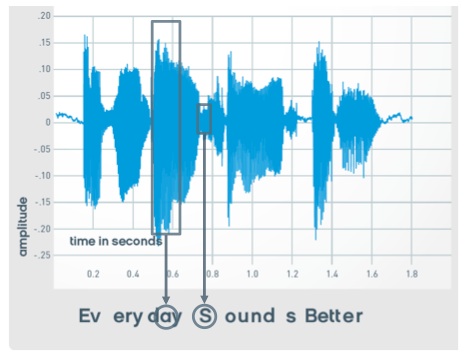
Figure 1. Speech is complex and dynamic.
A healthy cochlea quickly measures the input level of incoming sounds, and quickly controls the amplification of that sound. It amplifies when necessary and compresses loud sounds when necessary. This speed is key to maintaining natural sound quality.
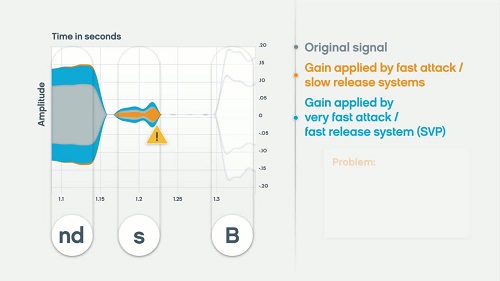
In Video 2, we use the tagline 'Every day sounds better’ to hone in on a specific segment of signal: the 'nd,' 's,' and 'b' sounds. The video compares the gain for these sounds, provided by the SVP system with fast attack and release times as compared to a traditional system with fast attack and slow release times.
In the video, you see that the original signal is in grey. The orange area represents the gain from a “traditional” system that has a fast attack and slow release time, which is the type of amplification that many of our competitors use in the industry. The blue area represents amplification provided by SVP, which is our fast attack and fast release system.
Look at the ‘nd’ signal (at the end of the word 'sound'). There was a strong vowel sound leading up to the ‘nd’ that carried a lot of energy (in grey) into the “nd” sound. As such, the traditional system and SVP had ample time over that longer period to quickly and accurately apply the gain level, because that's a very long signal.
Now, look what happens with the “s” sound. The traditional system with its slow release time did not release from the prior “nd” sound, so it completely underamplifies the ‘s,’ without providing any assistance of gain. Because the SVP has a fast attack and fast release time, it released the ‘nd’ in time to correctly provide the amplification for the 's' sound.
With the ‘b’ sound, the traditional system overamplifies it. Recognizing that the prior “s” sound was a small phoneme, it provided a lot of amplification. However, not knowing that the 'b' signal was coming, it resulted in over amplification of the ‘b,’ completely overshooting the appropriate modification for that already large signal.
What do our patients tell us when they're wearing traditional amplification? They report to us that things sound harsh, sharp and shrill. Those complaints are due to the slow release system found in traditional amplification. Speed is the key to accuracy. Because SVP is able to release and quickly attack again, we are able to accurately measure the appropriate amount of amplification for sounds of various levels.
Frequency Contrast
Freqeuncy contrast is not often addressed or mentioned by our competitors. However, frequency contrast is very important. The healthy cochlea preserves the natural level differences across frequencies for each phoneme, and we refer to that as frequency contrast. Most importantly, it is critical when it comes to speech clarity because you need maintain frequency differences between similar phonemes to be able to tell them apart.
If we don't have a system that responds fast enough, how do we know that person's brain is going to distinguish an 'uh' versus an 'e' versus a 't' 'k' 'sh'? Those are all phonemes that have tiny bits of energy. Our brain has the catalog to determine what that frequency contrast is for each sound. SVP takes frequency contrast into consideration. Frequency contrast is the key to clarity.
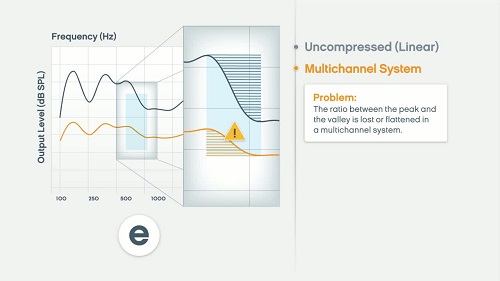
In Video 3, we use grey for the uncompressed/linear signal, orange is traditional amplification/multichannel system, and blue is the SVP signal.
In this case, we are focusing on the sound “ee”. As you can see in the video, with the traditional system we are losing a great amount of specificity. The ratio between the peak and valley is lost or flattened. Consider this: we have a four-channel instrument in this traditional multi-channel system, but the audiogram most likely has more than four different thresholds. If we take the audiogram, and plug it into the fitting software, we're going to be taking an average of an average. Anyone who has ever taken a statistics course knows you can't take an average of an average; but that's exactly what is happening in this multi-channel system. We're taking the wide signal, divvying it up into chunks, taking an average of an average and combining them together. Unfortunately, we’re losing all the nuances that make that phoneme special. If we completely lose that specificity, we have a problem. How is the brain supposed to figure that out?
SVP maintains the peak-to-valley ratio, so the brain is able to say, "Aha, what I used to know as an 'ee' sound is still an 'ee' sound." We are reducing the stress for that user.
Frequency Transfer
Most manufacturers today use some variety of frequency transfer. Frequency transfer by Sonic copies and compresses the high frequency input, transferring it to a lower frequency region that has better residual hearing. A lot of systems out there have a feature that does this. However, there are very unique components to Sonic’s approach.
The benefit is simple and clear: it improves access and therefore audibility of speech cues, keeping the full bandwidth intact for a seamless, natural sound. Some competitive products take a very wide chunk of frequencies and compress them into a very narrow band. The Sonic system does not do that; we want to keep the full bandwidth intact as much as possible. It provides a slight amount of compression, but it is minimal.
The feedback we have received from our patients using Frequency Transfer is that they've never heard like this before. It sounds like how they used to hear.

Video transcript: Frequency Transfer from Sonic helps restore high frequency sounds that are crucial for speech understanding and for enjoying everyday surroundings. Developed specifically for patients with severe high frequency hearing loss, Frequency Transfer is ideal when the audiogram indicates normal hearing in the low to mid-frequencies, then steeply declines in the high frequencies. This technology also helps with more severe hearing losses. Many hearing instruments have a difficult time amplifying this region due to gain limits, the potential for feedback, or when hair cells are unable to transmit the sound due to the amount of hearing loss. Frequency Transfer helps overcome these challenging situations.
Frequency Transfer identifies high frequency information in regions where hearing is poor, then copies, compresses, and shifts it to a lower frequency where the patient has better hearing. As a result, high frequency sounds such as the consonants 's' or 'z' can be heard. This can make a big impact on speech understanding.
Frequency Transfer is designed to help patients with sensorineural losses with a 20 dB per octave slope after 1000 Hz or where high frequency thresholds are at 70 dB and greater. Let's see what happens in a traditional first fit without frequency transfer. Here is a typical, severely sloping high frequency hearing loss as shown in dB HL. Here is the same audiogram in dB SPL. In the first fit, the green line represents the output of the hearing aid. The patient's hearing threshold is in grey. When the hearing aid output is above the hearing threshold, sounds are audible. When the output is below the hearing threshold, sounds cannot be heard, even when amplified. The high frequency sound of the letter 's' falls under the threshold of hearing in the grey shaded area of this audiogram. Without Frequency Transfer, it is not loud enough to be heard.
Now, let's see Frequency Transfer in action. Here's the same hearing aid output and high frequency loss threshold. This time, when Frequency Transfer is enabled, the high frequency speech cues that are below the hearing threshold are copied, compressed, and shifted. The sounds are moved above the hearing threshold to a frequency range where the patient has better hearing and the sounds become audible.
Unlike other frequency lowering strategies, Frequency Transfer activates based on a patient's audiogram. It copies and shifts all designated high frequency cues and, importantly, the full extended bandwidth of the original signal remains intact after the transfer. To help patients even more, the default settings for Frequency Transfer can be customized for three different intensity levels.
Patients and hearing care professionals will appreciate the benefits of Frequency Transfer. It effectively restores important speech cues by relocating high frequency sounds. It is easy for hearing care professionals to use since activation and default settings are automatically determined by the audiogram. And since the original bandwidth is preserved, sounds remain natural and comfortable. Thanks to Frequency Transfer, patients with high frequency hearing loss can enjoy a rich, full spectrum of sounds and that makes for a better hearing experience every day. End of video.
Frequency Transfer is not necessary for every patient. There are specific criteria required that would engage the Frequency Transfer in the EXPRESSfit fitting system. As the clinician, you have the flexibility to decide whether you want to engage it or not, and how strong or intense you want it to transfer, if at all. You can pick the frequency region. The software will do this automatically for you, but again, you are the expert. Here at Sonic, we want to make sure we're giving you all the tools you need to be successful. As an organization, our mission is not to dictate what you should do. What we want is to give you the flexibility to be successful in your fittings with your patients.
Noise Management
Our Celebrate products have a lot of systems working to manage noise, including Speech Priority Noise Reduction, Impulse Noise Reduction, Soft Noise Reduction, Wind Noise Reduction, Adaptive Feedback Canceller, and Reverb Reduction.
Speech Priority Noise Reduction (SPNR)
SPNR is noise reduction that gives speech the priority. We monitor the input and determine the modulation fingerprint of that signal. Highly modulated signals are preserved, where steady state noise (e.g., white noise, pink noise, crowd noise) is attenuated. The benefit of SPNR is clear: to provide comfort and preserve speech intelligibility of the signal.
Patients come in to our offices seeking help so they can hear better in noisy situations. A robust system is required to ensure success with amplification. SPNR is unique because we separate the speech from the noise. Traditional systems are slow to get started, so they're slow to engage and recognize the presence of noise. Once engaged, traditional systems unfortunately provide a flat level of attenuation. Consequently, with a flat level of attenuation, you not only attenuate noise, but you also attenuate speech, which is problematic. What is the patient going to do in that noisy environment? They're likely going to turn up their hearing aid. If they turn up the hearing aid, essentially they are turning up the noise.
If you would like to learn more, we have a separate course on AudiologyOnline specifically dedicated to this topic, as well as a white paper that you can download from our website at https://www.sonici.us/Sonic/For-professionals/Downloads/Technology-papers.aspx. For the purposes of today’s presentation, I wanted to give you a quick overview of SPNR.
SPNR runs on the engine of SVP. It's extremely fast and many things occur simultaneously. Think about it from a layered technology approach. SPNR is so fast it's going to recognize noise quickly, engage when it needs to, then disengage, based on the signal-to-noise ratio. It's a very complex, very intelligent system. Only the Celebrate models have a “Very High” setting that will provide maximum attenuation of noise while preserving speech. It's a new offering that we have launched with the Celebrate technology.
Impulse Noise Reduction (INR)
Another problem that hearing aid wearers encounter is impulsive sounds. Impulse noises come on suddenly and unexpectedly; they are brief, but also very loud in intensity. Think about dishes clanking or going to a sporting event. Maybe you're attending your grandchild's soccer game and you hear the referee’s whistle blow. That is a very loud noise for the amplified ear. Our Impulse Noise Reduction (INR) listens for these impulsive sounds. As soon as they occur, fast-acting alpha compression is deployed, which makes the sounds comfortable and tolerable. Comfort is key, especially for brand-new hearing aid wearers. We live in a noisy world. We need to have a system in place to allow people to be comfortable while wearing hearing technology. Figure 2 shows the effect of INR. It is a very fast-acting output compression - a simple system, but truly a premium feature.

Figure 2. Effects of Impulse Noise Reduction.
Soft Noise Reduction
Soft Noise Reduction uses expansion to manage low-level sounds. When patients come into the office, no longer will they tell you that they hear their refrigerator running all the time, or that they hear their furnace or air conditioner kicking on, or that their microwave is loud. Soft Noise Reduction keeps those signals at bay so the brain can focus on speech. Our patients want amplification in order to communicate, to hear their grandchildren, and to hear their loved ones. We're seeing more and more younger professionals seeking help because they're having a hard time hearing in business meetings. Having a sophisticated system with all these different noise management methods is essential for success.
Wind Noise Reduction
Have you have ever listened to wind noise while wearing hearing aids? If hearing aids do not have a noise reduction system, the wind noise can be overwhelming and highly distracting. Our system listens for uncorrelated noise, which we have defined as wind, between the directional microphones. If we identify wind, we're going to change the polarity of the instrument, and apply some noise reduction, so the patient gets relief. Patients who previously had to remove their hearing instruments in windy situations, may now be able to keep them in due to this system.
Adaptive Feedback Canceller
Sonic’s Adaptive Feedback Canceller use phase cancellation and a feedback monitor to remove feedback signals before they are noticeable. The feedback signal will be inverted before it goes through to the user’s ears. The benefit is squeal-free, easy listening.
With regard to managing feedback, Sonic’s approach is unique within the industry. We have a component to our system similar to memory. The incoming signal gets memorized. If it's feedback, inverse phase cancellation will be applied to the signal to remove it. However, feedback will often hit the microphone again. When the signal comes back, the hearing instrument recognizes it as feedback and takes care of it right away. This memory component is what sets us apart, because the hearing instrument is working so quickly to manage and remove the feedback.
Reverb Reduction
Reverb Reduction is a Celebrate 100 premium level exclusive feature. Reverb Reduction by Sonic minimizes the amount of reverb that is amplified by attenuating the part of the signal that is reverberant. Listening comfort in a demanding listening environment is much improved when you employ Reverb Reduction. Many musicians wear our instruments, and anyone who is a musician knows that a little bit of reverb is desirable. If you remove it all, the sound will be very thin and empty. Our system achieves a correct balance where we provide a little needed reverb, but not an overwhelming amount.
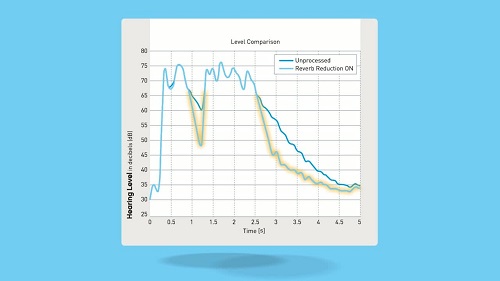
Video transcript: Our Reverb Reduction from Sonic helps patients enjoy their everyday surroundings by restoring clarity to sounds that are affected by reverberation. Speech that comes directly from a speaker sounds loud and clear and is easy to hear; but with increasing distance and challenging room acoustics, sound waves reflect off the walls, the ceiling, and other hard surfaces. These reflected sounds accumulate in the environment and reach the listener a short time later. These indirect reflections cause speech and other signals to sound unclear and to lose intelligibility.
Patients with hearing losses ranging from mild to profound can enjoy the benefits of Reverb Reduction, especially people who find themselves in a variety of environments like classrooms, gymnasiums, or hallways where reverb is most likely to occur.
Reverb Reduction looks for reverberation in four different regions in order to narrow in on its frequency location. Here is a signal containing reverb. Reverb is found between the pauses of speech and at the end of the sentence. Once reverb is identified in specific frequency regions, the algorithm determines its level and applies attenuation. It reduces most, but not all, of the reverberant signal. A small amount of reverb is necessary to make speech sound natural.
Let's see what happens before Reverb Reduction is applied. Here is the output of a signal without Reverb Reduction. The clean speech signal is blue. The offending reverberant signal is pink. Notice how the reverb overpowers much of the speech signal. Speech with reverberation sounds booming and unclear. As you can hear in the following example: “With Sonic, every day sounds better”.
Now, let's see reverb reduction in action. Here is the output of the signal with reverb reduction activated. Notice how the reverb has been drastically reduced to just the right level to make speech sound natural and comfortable. With reverb reduction on, the reverberation is now reduced to normal levels for the environment: “With Sonic, every day sounds better”.
Patients and hearing care professionals will appreciate the benefits of reverb reduction. It is easy to activate both in the software and on the hearing instrument. It effectively controls reverb in any environment and it always keeps speech and other sounds sounding natural, as intended. Thanks to Reverb Reduction, patients can enjoy speech that sounds natural and comfortable, no matter where they are, and that makes for a better hearing experience every day. End of video.
Binaural Environment Classification
We deploy Binaural Environment Classification in our wireless instruments. This provides a hands-free unified listening experience by automatically identifying the optimal environment. Instruments are typically optimized in five different settings: Speech in Noise, Speech in Quiet, Noise, Quiet, or Wind. As I mentioned earlier, ‘speech is king’ in everything we do at Sonic, and the hearing instruments are going to detect and manage accordingly.
Universal Environment
In the Universal Environment, which is where we deploy Environment Classification, the hearing aids treat your two ears as if they were one unit. We hear with our brain, so it makes sense that we would consider our ears as one system. If my left hearing instrument recognizes that there is a Speech in Noise signal, and my right hearing instrument detects only Noise, both instruments are going to optimize for Speech in Noise. Whenever speech is present, we will optimize for speech, except for one criteria: when wind is present.
With wind, we finally have instruments where a patient driving their car can roll down their window and still be able to have a conversation with passengers in the vehicle. The hearing instruments, again, are always communicating with each other to determine what signal is detected. If I'm driving a vehicle, and I roll down the window on my left side, my hearing instrument is going to automatically optimize for wind. It will then communicate to the right hearing instrument, which reports that it detects Speech in Noise (passenger conversations, music playing on the radio, general car sounds). In that environment, the hearing aids will not synchronize together, because we need to optimize for wind separately than for Speech in Noise.
Binaural Balance
We also deploy Binaural Synchronization. This ensures that any adjustments made to one hearing instrument will be made to the other hearing instrument, with regard to program change and volume control. We also have the Non-Telephone Ear Control. It will automatically recognize the non-telephone ear and the user can determine how they want the hearing instrument to respond: whether they want it to do nothing, to be muted, or simply to have a reduction in gain. By reducing the gain or muting, environmental noise distractions are lessened. The volume of the telephone ear hearing aid has not been increased; however, the person perceives that the telephone signal is louder. Therefore, the patient will experience less strain and stress during telephone conversations.
Speech Priority Volume Control (SPVC)
SPVC prioritizes volume adjustments for speech, thereby deploying greater focus on speech for comfort and balance between the two ears. Again, this is a Celebrate 100 exclusive feature.
Figure 3 demonstrates what happens within the instrument when you turn the volume up or down. On the left side of the figure, we're turning the volume up. As the patient increases the volume, more priority is given to the speech regions. The lows and highs will increase, but dramatically less than the mid region, the speech regions. This is a logical, intelligent application to adjust volume control. When the user turns up the volume, they don’t want more noise – they want speech.

Figure 3. Speech Priority Volume Control.
Conversely, when the patient decreases the volume, most likely they're in a noisy area and having a hard time hearing in the noise. In this scenario, shown on the right side of Figure 3, SPVC brings down the lows and the highs more than the mid-frequencies. More attention is paid to the lows and highs when you decrease the volume, versus the speech region because we still want the person to hear speech. Hearing speech with amplification is imperative, and intelligibility is important to us at Sonic.
Airplane Environment
We now have an Airplane Environment in our hearing instruments specifically designed for in-flight challenges. This is a Celebrate 100 exclusive program and features the highest level of noise reduction, optimized directionality, and high input level compression. Speech sounds remain intact for essential conversations in-flight. Airplanes and airports are extremely noisy. Between the parking garages, jet engine noise, overhead fans, and general cabin noise, it can be challenging for people with normal hearing in these loud environments. Imagine having a hearing impairment and using hearing aids that amplifies all those sounds. Think about a traditional hearing aid system that has traditional noise reduction: everything is attenuated, including the speech. The Airplane Environment will attenuate the noise so that speech sounds remain intact.
Full Customization
Exclusively within our Celebrate 100 level products, we also offer Custom Environment, where you can customize a program for any unique environment, within the EXPRESSfit fitting system. You can configure all the features, settings and frequency shaping to your own specifications.
Connectivity is Key
We live in a connected world and our customers demand hassle-free connectivity. With the Celebrate line, Sonic is able to accommodate the mobile and wireless needs of today’s modern living.
SoundGate 3 is the hub of connectivity accessories, connecting virtually any Bluetooth-enabled product. It has an exceptional battery life, program and volume control changes, and works with our SoundLink app.
SoundLink App is a free app available for iPhone and Android smart phones. You can view Bluetooth sources in range, view battery status, change the volume and program, and change the listening source. You can do most anything through the app that you could manually do at ear level or via the remote.
SoundGate Mic is our personal, private connection. Think of this as your remote mic. You can clip it onto a conversational partner, or place it in a table in a busy meeting area. It is lightweight and discrete. It's great for churches that don't have a loop system; in this instance, the minister would simply clip it on.
The RC-N is our remote control. It's lighter and smaller than our previous version. It provides basic functionality for people that are not interested in Bluetooth connectivity. They can still have access to increase and decrease volume, make program changes, and have a mute capability. RC-Ns are a great solution for caregivers who have loved ones in a living facility or a nursing home.
FittingLINK, the Sonic wireless programmer, is available for any of our wireless instruments. EXPRESSfit incorporates real ear verification into the fitting system. This enables you to achieve accurate fittings and improve satisfaction from the start.
Model Overview
Figure 4 provides an overview of all the Celebrate models available, from the Invisible-in-Canal (IIC) to the Power BTE.
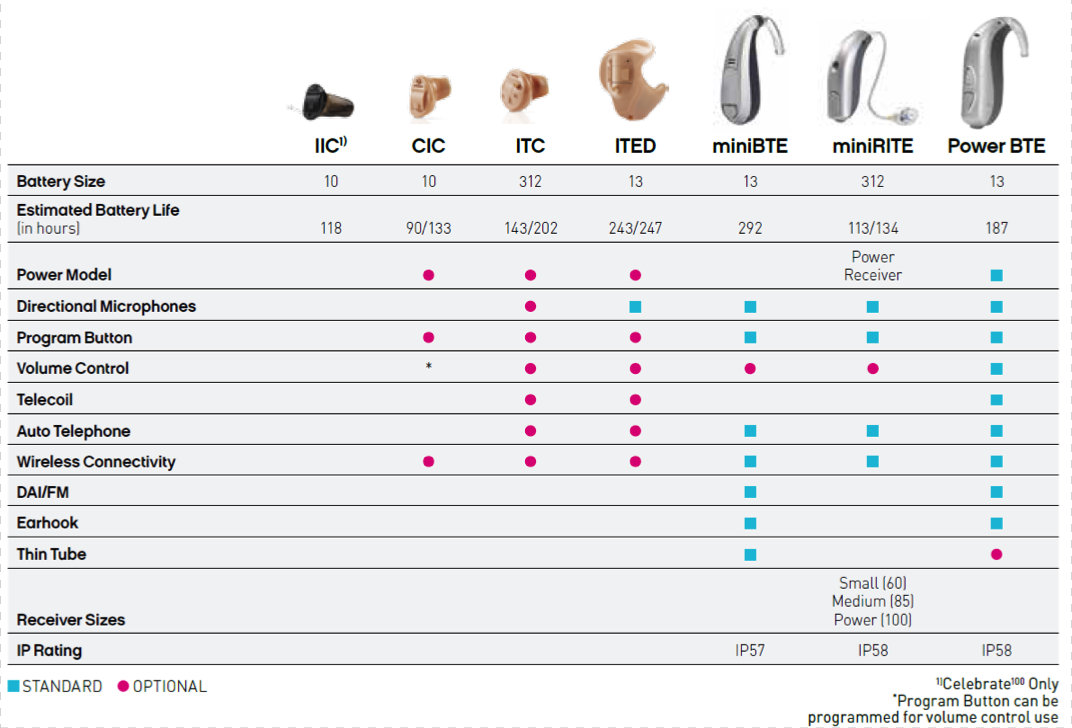
Figure 4. Model overview.
miniRITE
The miniRITE is extremely popular. It features a sleek, attractive design with a 312 battery. It has three receiver options, multiple domes and custom molds available. We offer six color choices: beige, taupe, brown, light grey, dark grey, and black. With regard to acoustic performance, we offer a 60, 85, and 100 level speaker. Those numbers are going to roughly equate to the recommended fitting range for each audiogram.
miniBTE
The miniBTE is available in earhook or thin tube configurations. With the thin tube, we offer the 0.9 or 1.3 millimeter option. In keeping with the mini concept, it uses the same domes as the miniRITE. Simplicity is part of our 4S Foundation; we do everything we can to simplify the supplies that you need in your office. There are four different lengths for tubing (0, 1, 2, and 3). The domes available are: open, bass double vent, single bass vent, and the power dome. Acoustic performance is a 125/58.
Power BTE
With the Power BTE, you can use the miniFIT system, if you want to use a thin tube fitting, or an earhook. It features a sleek design with a 13 battery. It has the power patients are looking for and the tactile controls are easily accessible. With regard to acoustic performance, we offer a 134/68; maximum fitting range gpes up to 100 dB.
Celebrate Custom Models
We offer continued excellence in the custom arena. We have best-in-class microphone and receiver protection with four new models in the Celebrate lineup. The course handout provides a chart with an overview of the custom products' acoustic performance.
Due to patient demand, we now have push-button volume control capability in our miniRITE, BTE, and in wireless custom instruments. For current Celebrate instruments that your patients may have, you will receive the push button volume control capability via a firmware update in EXPRESSfit 2016.
Summary
To review, we have the Celebrate 100 (premium level) and the Celebrate 80 (advanced level) technologies. We offer SVP as our digital signal processor. There are a few features that are available only in the 100, such as Impulse Noise Reduction, Reverb Reduction, Speech Priority Volume Control, Airplane Environment and Custom programming.
If you have any questions, please don't hesitate to reach out to me directly at erre@sonici.com or at 888-423-7834. Thank you for your time and attention.
Citation
Reichert, E. (2016, September). Introducing Celebrate. AudiologyOnline, Article 18176. Retrieved from https://www.audiologyonline.com.


